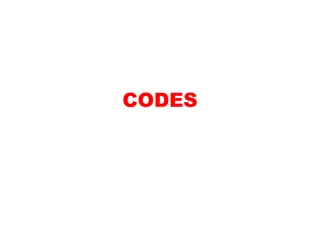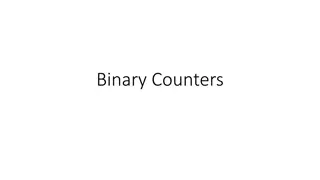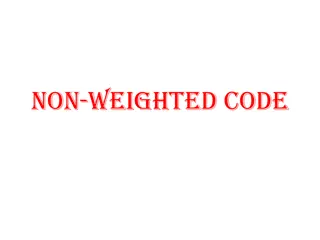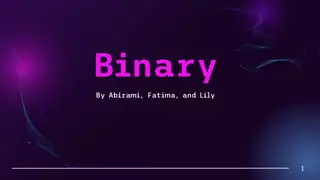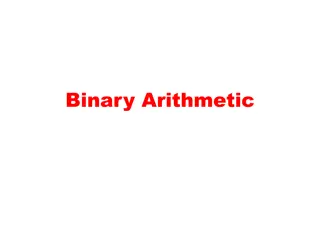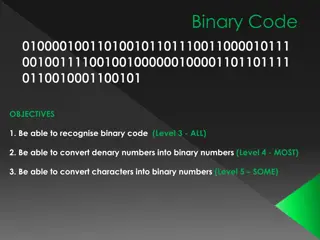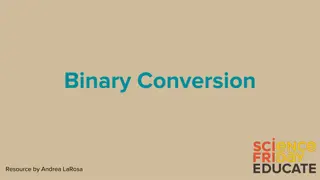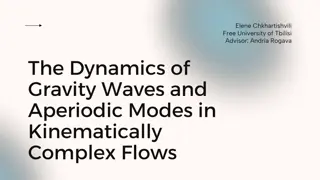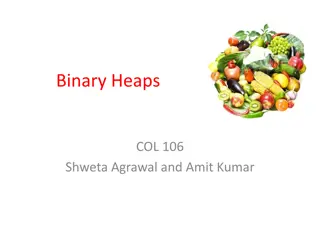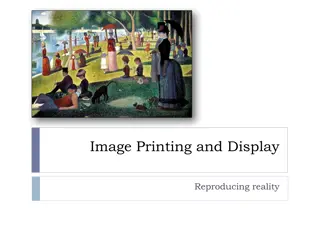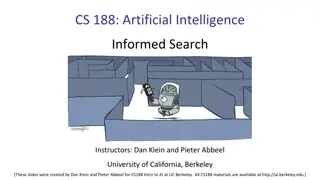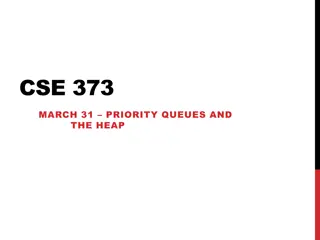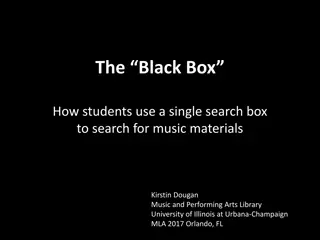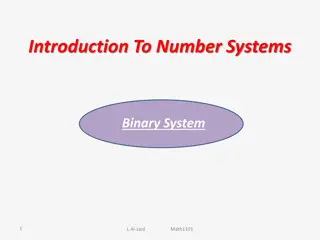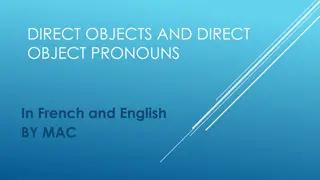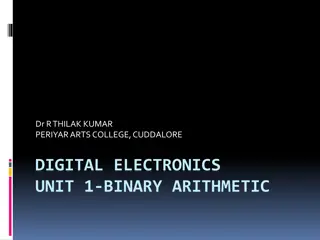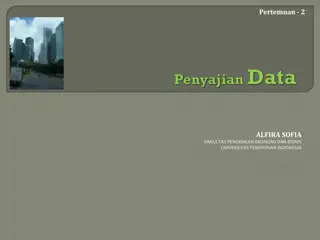Advancements in Aperiodic Dispersed-Dot Halftoning Using Direct Binary Search
Advancements in aperiodic, dispersed-dot halftoning, particularly focusing on adapting the Direct Binary Search algorithm for use with clustered-dots and Indigo liquid EP printing technology. The study addresses challenges in achieving high-quality prints with dispersed-dot halftoning on EP presses and discusses the transition from dispersed-dots to clustered-dots. Topics include Overview of DBS and CLU-DBS, MS-MP-CLU-DBS Screen Design, and applications in commercial and high-end digital printing. The research aims to enhance the print quality and stability of aperiodic halftoning methods for various printing technologies.
Download Presentation

Please find below an Image/Link to download the presentation.
The content on the website is provided AS IS for your information and personal use only. It may not be sold, licensed, or shared on other websites without obtaining consent from the author.If you encounter any issues during the download, it is possible that the publisher has removed the file from their server.
You are allowed to download the files provided on this website for personal or commercial use, subject to the condition that they are used lawfully. All files are the property of their respective owners.
The content on the website is provided AS IS for your information and personal use only. It may not be sold, licensed, or shared on other websites without obtaining consent from the author.
E N D
Presentation Transcript
New results for aperiodic, dispersed-dot halftoning* Jiayin Liua , Altyngul Jumabayevaa, Yujian Xua, Yin Wanga, Tal Frankb, Shani Gatb, Orel Bat Morb, Yotam Ben-Shoshanb, Robert Ulichneyc, and Jan Allebacha aSchool of Electrical and Computer Engineering, Purdue University, West Lafayette, IN 47907, U.S.A.; bHewlett-Packard Indigo Division, Rehovot, Israel; cHewlett-Packard Laboratories USA, Cambridge, MA 02142, U.S.A. *This work was supported by HP Inc., Indigo Division, Israel -1-
MS-MP-CLU-DBS Screen Design Using DBS -2-
About the authors (2/3) P. Goyal, M. Gupta, C. Staelin, M. Fischer, O. Shacham, J. Allebach, Clustered-Dot Halftoning with Direct Binary Search, IEEE Trans. on Image Processing, Vol. 22, pp. 473-487, February 2013. -4-
About the authors (3/3) Liu, A. Jumabayeva, Y. Xu, Y. Wang, T. Frank, S. Gat, O. Bat Mor, Y. Ben- Shoshan, R. Ulichney, and J. Allebach, New results for aperiodic, dispersed-dot halftoning, Color Imaging XXV: Displaying, Processing, Hardcopy, and Applications, (Part of IS&T Electronic Imaging 2020), R. Eschbach, G. Marcu, and A. Rizzi, Eds., Burlingame, CA, 26 January - 30 January 2020. -5-
Big picture FM (Frequency modulation) halftoning (aperiodic and dispersed-dots) is increasingly popular with traditional analog offset lithographic printing. There is a desire from customers in the commercial market to use this capability with high-end digital presses based on electrophotographic printing (EP) technologies. However, the inherent instability of the EP process challenges the achievement of satisfactory print quality with dispersed-dot, aperiodic halftoning. The direct binary search (DBS) algorithm is widely considered to represent the gold standard of dispersed-dot, aperiodic halftone image quality. We continue our previous efforts to adapt DBS from dispersed-dots to clustered-dots to use with the Indigo liquid EP printing technology. -6-
What we will specifically talk about today? Overview of DBS and CLU-DBS MS-MP-CLU-DBS Screen Design -7-
Direct Binary Search (DBS) Framework ?[?]: original continuous-tone image ? ? : Human visual system (HVS) filter ? ? : perceived original continuous-tone image ? ? = ? ? ? ? : perceptually filtered error ?[?]: halftoned image ? = | ? ? |2??: mean-squared perceptually filtered error ? ? : perceived halftoned image -8-
Dispersed-dots to clustered-dots Since printers using electrophotographic (EP) technology cannot render isolated dots stably, what we found is that clustered-dots halftones would give us a better print quality without losing details in highlights or shadows. The DBS optimization framework had been modified to design stochastic, clustered-dot texture, by using filters with different sizes in the initialization and update steps of the algorithm. -9-
Cost metric for CLU-DBS* * P. Goyal, M. Gupta, C.Staelin, M. Fischer, O. Shacham and J. Allebach Clustered-Dot Halftoning With Direct Binary Search IEEE Transactions on Image Processing, vol. 22, no.2, pp. 473 487, Feb. 2013. -10-
CLU-DBS Difference between Conventional DBS and CLU-DBS Difference Initialization filter Update filter ? ? ? ? ? ? ? ? -11-
Factors influencing CLU-DBS halftone texture Seed halftone Filter type Filter scale parameter Relation between halftone frequency and filter size Multi-Pass refinement Multi-State refinement -12-
MP-CLU-DBS Multi-pass (MP) refinement Is used to refine the halftone texture. A pass is a complete refinement consisting of multiple iterations of the CLU- DBS algorithm. Single pass: Seed Halftone Final halftone CLU-DBS Iteration 2 Iteration 1 Iteration n ... DBS Initialization filter Update filter Multi-pass: Each re-optimization is carried out with the original filters, and this leads to a homogenous texture. Seed Halftone MP-CLU-DBS ... CLU-DBS CLU-DBS CLU-DBS Optimal Halftone From Pass 2 Optimal Halftone From Pass n Optimal Halftone From Pass 1 -13-
Halftone Result of MP-CLU-DBS Original image Gray level = 127/255 Halftone result based on MP-CLU-DBS Pass 3 Pass n Pass 1 Pass 2 -14-
MS-MP-CLU-DBS Multi-stage (MS) optimization Is the core part of the algorithm. Starting with a seed halftone, the key idea is to build up the continuous-tone (CT) image stage-by-stage. The absorptance value of the continuous-tone image in each stage is controlled by attenuation factors. -15-
MS-MP-CLU-DBS MS-MP-CLU-DBS: Stage 2 continuous- tone image Stage K continuous- tone image Stage 1 continuous- tone image Stage K Stage 1 Stage 2 ... MP-CLU-DBS MP-CLU-DBS MP-CLU-DBS Seed Halftone Stage 2 halftone result Stage K halftone result Stage 1 halftone result 5 stages in all attenuation factors: {0.2, 0.4, 0.6, 0.8, 1.0} Original image Stage 5 Stage 4 Stage 1 Stage 2 Stage 3 continuous -tone image Gray level = 127/255 Halftone result Seed Halftone -16- Gray level = 7.5/255
MS-MP-CLU-DBS applied to a continuous-tone folded ramp MS = 5; MP = 10 -17-
Outline Overview of DBS and CLU-DBS MS-MP-CLU-DBS Screen Design Screen design procedure Desired LPI (halftone frequency) Halftone quality and metrics -18-
Screen Design A screen is a threshold matrix that can be used to halftone any input image by pixel-wise comparison of the image with the screen. A screen is constructed by designing halftones for each gray-level in the tonal range in some specified sequence with stacking constraints applied. Generating a halftone from a screen is much faster than generating a halftone by directly applying MS-MP-CLU-DBS. Our goal of the screen is to generate a halftone that would have texture quality similar to that of direct MS-MP-CLU-DBS. -19-
MS-MP-CLU-DBS based screen design Generate a threshold matrix that is based on MS-MP-CLU-DBS 1. Giving an initial level that is between 0-255 (in our case, gray-level of 127), and generate a continuous-tone patch size of 256 256. Use MS-MP-CLU-DBS to generate desired halftone of gray-level 127. Set seed halftone level to be 7.57, where absorptance of seed halftone has function of , is desired frequency in lpi and R is the printer resolution in dpi. =280 lpi, R=1625.6 dpi. * MS=5 and MP=10. Add or delete a sufficient number of dots to or from the initial halftone to reach the exact gray-level of 127. Use toggle-only to generate levels below the initial level with stacking constraints by removing 256 pixels at each level. Each new dot is removed in a greedy fashion by exploring all possible locations and picking the one that either deceases the cost the most or increases it the least. Use toggle-only to generate levels above the initial level with stacking constraints by adding 256 pixels at each level. Each new dot is added in a greedy fashion by exploring all possible locations and picking the one that either deceases the cost the most or increases it the least. Generate threshold matrix based on the above procedure. 2. a. b. 3. 4. a. 5. a. 6. * M. Gupta, PhD Dissertation, Clustered-dot Halftoning with Direct Binary Search , Jan. 2010 -20-
An example Gaussian parameters: ?????= 2, ???????= 2.5 Screen size: 256 256 Patch size: 256 256 = Initial level of 127 Level: 126 Difference = 256 dots Generated from Initial level of 127 with stacking constraints by removing 256 dots -21-
Comparison with direct MS-MP-CLU-DBS Gaussian parameters: ?????= 2 ,???????= 2.5 Screen size: 256 x 256 Generated from direct MS-MP-CLU-DBS Generated from Screen Seed halftone: 7.57 -22-
Outline Overview of DBS and CLU-DBS MS-MP-CLU-DBS Screen Design Screen design procedure Desired LPI (halftone frequency) Halftone quality and metrics -23-
Desired LPI (halftone frequency) From our previous work, we noted that applying Gaussian filters with various values of ? would cause the frequency of the halftone to vary. We tried several Gaussian filters to get a combination that the halftone generated would have better print quality and reach to desired halftone frequency (260 lpi ~ 280 lpi). For each ? combination, we generated a screen from it and applied the screen to constant continuous-tone patches to get halftones. Our method to determine the frequency associated with a halftone is to locate the maximum in the Radially Averaged Power Spectrum (RAPS) curve, computed from the Fourier transform of the halftone*. We found that applying the combination of ?????= 1.3, ???????= 1.7 to the screen design would give us a better texture quality and a very stable halftone frequency of 268.21 lpi. * R. Ulichney, Dithering with blue noise, Proc. IEEE, vol. 76, pp. 56 79, Jan. 1988. -24-
Level 16 Gaussian parameters: ?????= 1.3, ???????= 1.7 Screen size: 256 256 ?????: 268.21 lpi -25-
Apply the new screen to a folded ramp ?????= 1.3, ???????= 1.7 -26-
Outline Overview of DBS and CLU-DBS MS-MP-CLU-DBS Screen Design Screen design procedure Desired LPI (halftone frequency) Halftone quality and metrics -27-
Halftone quality and metrics Parameters: ?????= 1.3, ???????= 1.7 Screen size: 256 256 Total number of levels: 256 Gray-levels that I generated: 16, 32, 48, 64, 80, 96, 112, 128, 144, 160, 176, 192, 218, 224, 240. Pair Correlation 2D Fourier Spectrum Magnitude Radially Average Power Spectrum -28-
Pair Correlation Level 16 Level 64 Level 128 D. L. Lau, G. R. Arce, and N. C. Gallagher, Green-noise digital halftoning, Proc. IEEE, vol. 86, pp. 2424 2444, Dec. 1998. -29-
2D Fourier Spectrum Magnitude Level 16 Level 64 Level 128 -30-
Radially Average Power Spectrum Level 16 ?????: 268.21 lpi ?????: 268.21 lpi Level 64 ?????: 268.21 lpi Level 128 R. Ulichney, Dithering with blue noise, Proc. IEEE, vol. 76, pp. 56 79, Jan. 1988. -31-
Conclusion We have performed a screen design based on MS-MP-CLU-DBS to generate aperiodic clustered-dots halftones to use with the Indigo liquid EP printing technology. We have explored a combination of Gaussian filters, and chose a combination that yields good halftone quality and the desired LPI based on the maximum in the Radially Averaged Power Spectrum (RAPS) curve. We have shown that our screen design has a very stable LPI. We have used several metrics to validate our screen-based halftone quality. -32-
Thank you! -33-


